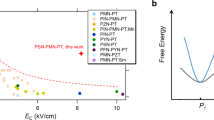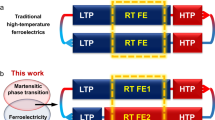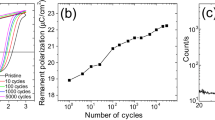Abstract
Materials that can produce large controllable strains are widely used in shape memory devices, actuators and sensors1,2, and great efforts have been made to improve the strain output3,4,5,6. Among them, ferroelastic transitions underpin giant reversible strains in electrically driven ferroelectrics or piezoelectrics and thermally or magnetically driven shape memory alloys7,8. However, large-strain ferroelastic switching in conventional ferroelectrics is very challenging, while magnetic and thermal controls are not desirable for practical applications. Here we demonstrate a large shear strain of up to 21.5% in a hybrid ferroelectric, C6H5N(CH3)3CdCl3, which is two orders of magnitude greater than that in conventional ferroelectric polymers and oxides. It is achieved by inorganic bond switching and facilitated by structural confinement of the large organic moieties, which prevents undesired 180° polarization switching. Furthermore, Br substitution can soften the bonds, allowing a sizable shear piezoelectric coefficient (d35 ≈ 4,830 pm V−1) at the Br-rich end of the solid solution, C6H5N(CH3)3CdBr3xCl3(1−x). The electromechanical properties of these compounds suggest their potential in lightweight and high-energy-density devices, and the strategy described here could inspire the development of next-generation piezoelectrics and electroactive materials based on hybrid ferroelectrics.
This is a preview of subscription content, access via your institution
Access options
Access Nature and 54 other Nature Portfolio journals
Get Nature+, our best-value online-access subscription
$29.99 / 30 days
cancel any time
Subscribe to this journal
Receive 12 print issues and online access
$259.00 per year
only $21.58 per issue
Buy this article
- Purchase on Springer Link
- Instant access to full article PDF
Prices may be subject to local taxes which are calculated during checkout




Similar content being viewed by others
Data availability
The data supporting the findings of this study are available within the article and its Supplementary Information or on figshare.com, https://doi.org/10.6084/m9.figshare.13227434.
Change history
18 January 2021
A Correction to this paper has been published: https://doi.org/10.1038/s41563-021-00929-0
References
Trolier-McKinstry, S. & Muralt, P. Thin film piezoelectrics for MEMS. J. Electroceram. 12, 7–17 (2004).
Mohd Jani, J., Leary, M., Subic, A. & Gibson, M. A. A review of shape memory alloy research, applications and opportunities. Mater. Des. 56, 1078–1113 (2014).
Park, S.-E. & Shrout, T. R. Ultrahigh strain and piezoelectric behavior in relaxor based ferroelectric single crystals. J. Appl. Phys. 82, 1804–1811 (1997).
Pelrine, R., Kornbluh, R., Pei, Q. & Joseph, J. High-speed electrically actuated elastomers with strain greater than 100%. Science 287, 836–839 (2000).
Ren, X. Large electric-field-induced strain in ferroelectric crystals by point-defect-mediated reversible domain switching. Nat. Mater. 3, 91–94 (2004).
Lai, A., Du, Z., Gan, C. L. & Schuh, C. A. Shape memory and superelastic ceramics at small scales. Science 341, 1505–1508 (2013).
Chopra, H. D., Ji, C. & Kokorin, V. V. Magnetic-field-induced twin boundary motion in magnetic shape-memory alloys. Phys. Rev. B 61, R14913–R14915 (2000).
Nagarajan, V. et al. Dynamics of ferroelastic domains in ferroelectric thin films. Nat. Mater. 2, 43–47 (2003).
Otsuka, K. & Ren, X. Physical metallurgy of Ti–Ni-based shape memory alloys. Prog. Mater. Sci. 50, 511–678 (2005).
Chmielus, M., Zhang, X. X., Witherspoon, C., Dunand, D. C. & Müllner, P. Giant magnetic-field-induced strains in polycrystalline Ni–Mn–Ga foams. Nat. Mater. 8, 863–866 (2009).
Hao, J., Li, W., Zhai, J. & Chen, H. Progress in high-strain perovskite piezoelectric ceramics. Mater. Sci. Eng. R 135, 1–57 (2019).
Meng, H. & Hu, J. A brief review of stimulus-active polymers responsive to thermal, light, magnetic, electric, and water/solvent stimuli. J. Intell. Mater. Syst. Struct. 21, 859–885 (2010).
Huber, J. E., Fleck, N. A. & Ashby, M. F. The selection of mechanical actuators based on performance indices. Proc. R. Soc. Lond. A 453, 2185–2205 (1997).
Mitzi, D. B. Templating and structural engineering in organic–inorganic perovskites. J. Chem. Soc. Dalton Trans. 1–12 (2001).
Li, W. et al. Chemically diverse and multifunctional hybrid organic–inorganic perovskites. Nat. Rev. Mater. 2, 16099 (2017).
Chen, B. et al. Large electrostrictive response in lead halide perovskites. Nat. Mater. 17, 1020–1026 (2018).
Shu, L. et al. Photoflexoelectric effect in halide perovskites. Nat. Mater. 19, 605–609 (2020).
Liao, W.-Q. et al. A molecular perovskite solid solution with piezoelectricity stronger than lead zirconate titanate. Science 363, 1206–1210 (2019).
You, Y.-M. et al. An organic-inorganic perovskite ferroelectric with large piezoelectric response. Science 357, 306–309 (2017).
Tang, Y.-Y. et al. Multiaxial molecular ferroelectric thin films bring light to practical applications. J. Am. Chem. Soc. 140, 8051–8059 (2018).
Aizu, K. Possible species of ‘ferroelastic’ crystals and of simultaneously ferroelectric and ferroelastic crystals. J. Phys. Soc. Jpn 27, 387–396 (1969).
Malakooti, M. H. & Sodano, H. A. Direct measurement of piezoelectric shear coefficient. J. Appl. Phys. 113, 214106 (2013).
Brochu, P. & Pei, Q. in Electroactivity in Polymeric Materials (ed. Rasmussen, L.) 1–56 (Springer, 2012).
Altammar, H., Dhingra, A. & Salowitz, N. Ultrasonic sensing and actuation in laminate structures using bondline-embedded d35 piezoelectric sensors. Sensors 18, 3885 (2018).
Viehland, D. et al. Effect of uniaxial stress on the large-signal electromechanical properties of electrostrictive and piezoelectric lead magnesium niobate lead titanate ceramics. J. Appl. Phys. 95, 1969–1972 (2004).
Guerin, S. et al. Control of piezoelectricity in amino acids by supramolecular packing. Nat. Mater. 17, 180–186 (2018).
Tressler, J. F., Alkoy, S. & Newnham, R. E. Piezoelectric sensors and sensor materials. J. Electroceram. 2, 257–272 (1998).
Li, F., Zhang, S., Xu, Z., Wei, X. & Shrout, T. R. Critical property in relaxor-PbTiO3 single crystals – shear piezoelectric response. Adv. Funct. Mater. 21, 2118–2128 (2011).
Damjanovic, D. Stress and frequency dependence of the direct piezoelectric effect in ferroelectric ceramics. J. Appl. Phys. 82, 1788–1797 (1997).
Bellaiche, L. & Vanderbilt, D. Intrinsic piezoelectric response in perovskite alloys: PMN-PT versus PZT. Phys. Rev. Lett. 83, 1347–1350 (1999).
Damjanovic, D. & Demartin, M. The Rayleigh law in piezoelectric ceramics. J. Phys. D 29, 2057–2060 (1996).
Li, F. et al. Ultrahigh piezoelectricity in ferroelectric ceramics by design. Nat. Mater. 17, 349–354 (2018).
Li, F. et al. Giant piezoelectricity of Sm-doped Pb(Mg1/3Nb2/3)O3-PbTiO3 single crystals. Science 364, 264–268 (2019).
Rodriguez, B. J., Callahan, C., Kalinin, S. V. & Proksch, R. Dual-frequency resonance-tracking atomic force microscopy. Nanotechnology 18, 475504 (2007).
Blöchl, P. E. Projector augmented-wave method. Phys. Rev. B 50, 17953–17979 (1994).
Perdew, J. P., Burke, K. & Ernzerhof, M. Generalized gradient approximation made simple. Phys. Rev. Lett. 77, 3865–3868 (1996).
Kresse, G. & Joubert, D. From ultrasoft pseudopotentials to the projector augmented-wave method. Phys. Rev. B 59, 1758–1775 (1999).
Grimme, S. Semiempirical GGA-type density functional constructed with a long-range dispersion correction. J. Comput. Chem. 27, 1787–1799 (2006).
Resta, R. Macroscopic polarization in crystalline dielectrics: the geometric phase approach. Rev. Mod. Phys. 66, 899–915 (1994).
King-Smith, R. D. & Vanderbilt, D. Theory of polarization of crystalline solids. Phys. Rev. B 47, 1651–1654 (1993).
Sheppard, D., Xiao, P., Chemelewski, W., Johnson, D. D. & Henkelman, G. A generalized solid-state nudged elastic band method. J. Phys. Chem. Lett. 136, 074103 (2012).
Dronskowski, R. & Bloechl, P. E. Crystal orbital Hamilton populations (COHP): energy-resolved visualization of chemical bonding in solids based on density-functional calculations. J. Phys. Chem. 97, 8617–8624 (1993).
Deringer, V. L., Tchougréeff, A. L. & Dronskowski, R. Crystal orbital Hamilton population (COHP) analysis as projected from plane-wave basis sets. J. Phys. Chem. A 115, 5461–5466 (2011).
Maintz, S., Deringer, V. L., Tchougréeff, A. L. & Dronskowski, R. LOBSTER: A tool to extract chemical bonding from plane-wave based DFT. J. Comput. Chem. 37, 1030–1035 (2016).
Acknowledgements
We acknowledge the Facility for Analysis, Characterisation, Testing and Simulation (FACTS) at Nanyang Technological University, Singapore, for access to the XRD facilities, X. R. Zhou (School of Materials Science and Engineering, Nanyang Technological University) for assistance in the piezoelectric measurements and F. Li (Xi’an Jiaotong University) for discussions on piezoelectric resonance measurements. L.Y. and B.X. acknowledge the startup funds from Soochow University and the support from Priority Academic Program Development (PAPD) of Jiangsu Higher Education Institutions. L.Y. also acknowledges the support from National Natural Science Foundation of China (12074278) and Key University Science Research Project of Jiangsu Province (20KJA140001). B.X. also acknowledges the support from National Natural Science Foundation of China under grant no. 12074277 and Natural Science Foundation of Jiangsu Province (BK20201404). H.J.F. acknowledges the support from AME Individual Research Grant (A1883c0004), Agency for Science, Technology, and Research (A*STAR). J.W. acknowledges the support from the Ministry of Education, Singapore (AcRF Tier 1 118/17 and 189/18) and the startup grant from Southern University of Science and Technology (SUSTech), China.
Author information
Authors and Affiliations
Contributions
Y.H., L.Y., H.J.F. and J.W. conceived the idea and designed the project. Y.H. grew the single crystals and performed the powder XRD measurements. S.A.M. and Y.H. conducted the powder XRD analysis. Y.L. and S.A.M. performed the single-crystal XRD characterization and analysis. Y.H. prepared the devices and carried out the PFM, ferroelectric, piezoelectric, dielectric, TGA and DSC measurements, and analysed the results with L.Y., J.W. and H.J.F. Y.H., T.L. and P.S.L. conducted the shear strain characterizations. B.X., Y.Z. and X.W. carried out the DFT calculations. Y.H., L.Y., H.J.F. and J.W. wrote the manuscript with input from all the authors.
Corresponding authors
Ethics declarations
Competing interests
The authors declare no competing interests.
Additional information
Peer review information Nature Materials thanks Gustau Catalan, Damien Thompson and the other, anonymous, reviewer(s) for their contribution to the peer review of this work.
Publisher’s note Springer Nature remains neutral with regard to jurisdictional claims in published maps and institutional affiliations.
Supplementary information
Supplementary Information
Supplementary Text 1–3, Figs. 1–11, Tables 1–4, captions for Videos 1–5 and refs. 1–47.
Supplementary Video 1
Real-time video of the ferroelastic switching cycle of the bulk (PTMA)CdBr0.45Cl2.55 single crystal at a frequency of 1 Hz (starting from left tilt to right tilt and back to left tilt).
Supplementary Video 2
Real-time video of the ferroelastic switching cycle of the bulk (PTMA)CdBr0.45Cl2.55 single crystal at a frequency of 1 Hz (starting from right tilt to left tilt and back to right tilt).
Supplementary Video 3
Real-time video of the ferroelastic switching cycles of the bulk (PTMA)CdBr2.7Cl0.3 single crystal at frequencies ranging from 0.5 to 20 Hz.
Supplementary Video 4
Sequential structural evolution of (PTMA)CdCl3 during the ferroelastic switching as derived from the switching path calculation.
Supplementary Video 5
Sequential structural evolution of (PTMA)CdBr3 during the ferroelastic switching as derived from the switching path calculation.
Rights and permissions
About this article
Cite this article
Hu, Y., You, L., Xu, B. et al. Ferroelastic-switching-driven large shear strain and piezoelectricity in a hybrid ferroelectric. Nat. Mater. 20, 612–617 (2021). https://doi.org/10.1038/s41563-020-00875-3
Received:
Accepted:
Published:
Issue Date:
DOI: https://doi.org/10.1038/s41563-020-00875-3
This article is cited by
-
Resolving electron and hole transport properties in semiconductor materials by constant light-induced magneto transport
Nature Communications (2024)
-
Tuning ferroelectric phase transition temperature by enantiomer fraction
Nature Communications (2024)
-
Superior ferroelectricity and nonlinear optical response in a hybrid germanium iodide hexagonal perovskite
Nature Communications (2023)
-
Bond engineering of molecular ferroelectrics renders soft and high-performance piezoelectric energy harvesting materials
Nature Communications (2022)
-
Biferroelectricity of a homochiral organic molecule in both solid crystal and liquid crystal phases
Nature Communications (2022)



